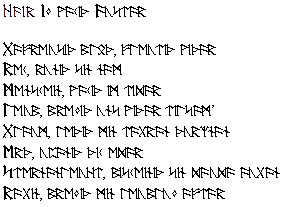  WritingIn Friland over 99% of the inhabitants are literate. At schools both the Frilandic runes and the Latin alphabet are taught, in which the last one is mainly used for international communication. For the visitors of this site Frilandic words are also written in Latin alphabet, even though runic writing is normally used for this. History of the runes The runes, also called "fuțark", originate from Scandinavia and/or the northern Alps. Due to their intensive trading contacts with other Germanic tribes the Frilanders soon adopted runic writing, probably in the 2nd century. Originally the runes were mainly used for magical purposes and for writing down short messages and religious incantations. However, in the 8th century the first literary works were written, for which the runes were used just like the Anglo-Saxons did. Most Western European countries soon switched to the Latin alphabet while the self-willed Frilanders stubbornly refused this with the motto: "If it ain't broke, don't fix it." Until the current day Friland is the only country in the world that kept using the traditional runic writing.
Just like the Latin alphabet the runes underwent a number of modernizations, like the use of capitals, italic and interpunction.  Spelling Each rune represents one or more sounds and is fully adapted for displaying the Frilandic language. However, other languages use sounds and spellings that can not be displayed with runes, therefore these are often written in the Latin alphabet or spelled phonetically. For example, the word "aqueduct" is then spelled as         ("ekwedakt"). ("ekwedakt").Example Below is a poem by Anshar Oțalwarssun in a runic serif typeface. Thereunder is the same poem in the Latin alphabet with next to it a translation. 
 |























